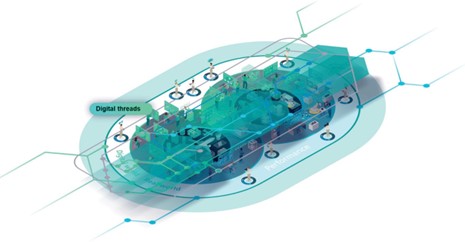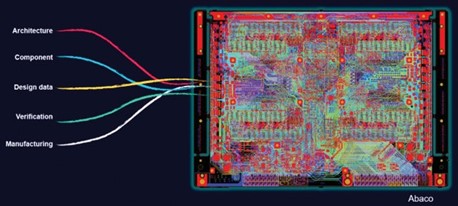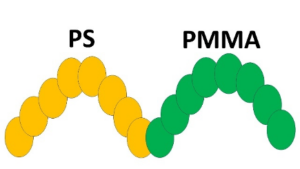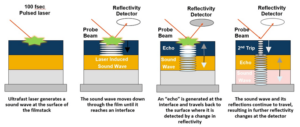Providing a seamless flow of data across various product lifecycle stages, domains, and disciplines.

By Matthew Walsh and Matt Bromley
Digital transformation involves the integration of digital technologies and the reimagining of business processes to enhance operations, improve customer experiences, and drive innovation. Digital threads are a key component of this transformation, as they enable the seamless flow of data and information across various stages of a process, system, or organization, and are thus pivotal for managing complexity and staying competitive in an ever-shifting electronics industry.
Digital threads collect, integrate, and manage data across the different stages of a product’s lifecycle. These threads enable a comprehensive view of the product, fostering collaboration, informed decision making, and optimized designs. The goal is to harness that data in more advanced and interactive ways, which is achieved through a digital twin. While the digital thread provides a structured pathway of data across the lifecycle, the digital twin utilizes this data to dynamically mirror the real-world state, behavior, and performance of a particular product.
The analogy of a subway map aptly describes the nature of digital threads. Essentially, if the digital thread is analogous to the subway map, with stops representing data points and subway lines the threads connecting them, then the digital twin is the real-time, interactive simulation of the entire subway system–trains, stations, and all–allowing stakeholders to anticipate issues, run scenarios, and gain insights that wouldn’t be possible with just the map alone. This seamless integration of the digital thread with the digital twin ensures a 360-degree approach to product design, operation, and maintenance in the digital era.
Fig. 1: Digital threads bridge silos to create closed-loop, data-driven linkages across domains.
Results from a Lifecycle Insights 2022 survey (“The ROI of Digital Transformation Benchmark Report”) revealed overwhelmingly positive outcomes. The survey involved 330 companies at the frontend of their digital transformation process. 10% of these firms found that their projects had not only met but exceeded their revenue targets, while 9% reported surpassing their profit margins. Furthermore, a noteworthy 20% of these organizations reported a substantial reduction in the number of prototypes required – confirmation of the positive impact of embracing digital transformation in their design and manufacturing processes.
When it comes to managing the complexity of electronic systems design, from ideation to manufacturing, there are five essential digital threads:
- Architecture digital thread: This thread focuses on the early architecture of a system, bridging the gap between high-level requirements and detailed design. Enabling this thread facilitates effective power budget allocation, traceability, and iterative refinement.
- Component digital thread: Addressing the broken component data exchange paradigm is vital. Standardized digital models of components through initiatives like JEDEC’s JEP30 standard is key to enhancing efficiency and reducing errors.
- Design data digital thread: This thread represents a sophisticated framework aiming to seamlessly synchronize varied design data elements within a digital landscape. For example, coordinating electronic computer-aided design (ECAD) and mechanical computer-aided design (MCAD) data to enable seamless collaboration and multi-domain simulations. This thread necessitates optimized data exchange formats, such as the IDX standard, to optimize design processes.
- Verification digital thread: Complexity drives the need for thorough verification. Establishing a digital thread that traces requirements, test cases, and verification results fosters efficiency, enhances traceability, and facilitates continuous verification throughout the development cycle.
- Manufacturing digital thread: The interaction between design and manufacturing is bidirectional. A robust manufacturing digital thread allows for continuous improvement by capturing manufacturing insights and enabling more informed, sustainable design decisions.
Fig. 2: The fabric of digital threads for electronic systems design and manufacturing.
Digital threads transcend domains
Electronic systems design doesn’t fit neatly within one domain or thread. Instead, it often spans multiple areas. The transcendent nature of the digital threads ensures that stakeholders across different domains can access relevant, up-to-date information and make informed decisions. This interconnected approach breaks down silos, reduces inefficiencies, and promotes a holistic view of the entire product lifecycle from concept through to end-of-life.
Therefore, it is essential that digital threads are not isolated to a particular domain; they transcend multiple domains. Indeed, the core principle of the digital thread is to provide a seamless flow of data and information across various product lifecycle stages, domains, and disciplines. By doing so, the digital thread ensures that information remains consistent, accessible, and traceable throughout the entire lifecycle of a product or system.
The digital thread is not merely a conceptual strategy but a transformative approach, redefining how electronics are designed, manufactured, and utilized. Ultimately, it is the foundation of the future; the blueprint of a digitally transformed electronics industry, where precision, collaboration, and innovation synergistically converge.
By embracing the digital thread model, businesses stand to benefit tremendously, from significant cost savings and efficiency gains to improved product quality and faster time-to-market. Yet digital threads represent more than a competitive advantage, they are an imperative for those striving to manage the accelerating complexity in electronic systems design and manufacturing.
To learn more about how your team can navigate and thrive amidst the intricate landscape of electronic systems design and manufacturing via a digital threads methodology, please read the Siemens EDA paper Mastering complexity leveraging digital threads for electronics systems design and manufacturing.
Matt Bromley is vice president, product strategy and technology, at Siemens EDA.
Matt Walsh
(all posts)Matthew Walsh is a product marketing manager in the Electronic Board Systems Division of Siemens Digital Industries Software. He is responsible for all cloud solutions. Walsh has 25+ years’ experience in semiconductor and electronics marketing, sales, and application engineering. He earned his BSEE at the University of Massachusetts. He is an avid skier and science fiction geek.
- SEO Powered Content & PR Distribution. Get Amplified Today.
- PlatoData.Network Vertical Generative Ai. Empower Yourself. Access Here.
- PlatoAiStream. Web3 Intelligence. Knowledge Amplified. Access Here.
- PlatoESG. Carbon, CleanTech, Energy, Environment, Solar, Waste Management. Access Here.
- PlatoHealth. Biotech and Clinical Trials Intelligence. Access Here.
- Source: https://semiengineering.com/five-digital-threads-unify-and-simplify-electronic-systems-design-and-manufacturing/
- :has
- :is
- :not
- :where
- 1
- 10
- 11
- 2022
- 29
- 32
- 360-degree
- a
- About
- accelerating
- access
- accessible
- achieved
- across
- addressing
- advanced
- ADvantage
- Aiming
- All
- All Posts
- allocation
- allows
- alone
- amidst
- an
- and
- anticipate
- Application
- approach
- architecture
- ARE
- areas
- AS
- At
- BE
- behavior
- Benchmark
- benefit
- between
- blueprint
- board
- breaks
- BRIDGE
- bridging
- Broken
- budget
- business
- business processes
- businesses
- but
- by
- CAN
- Capturing
- cases
- Cloud
- collaboration
- collect
- comes
- Companies
- competitive
- complexity
- component
- components
- comprehensive
- concept
- conceptual
- confirmation
- Connecting
- consistent
- continuous
- converge
- coordinating
- Core
- Cost
- cost savings
- create
- customer
- cycle
- data
- Data Exchange
- data points
- data-driven
- decision
- Decision Making
- decisions
- describes
- Design
- designed
- designs
- detailed
- Development
- different
- digital
- Digital Transformation
- digital twin
- digitally
- disciplines
- Division
- Doesn’t
- doing
- domain
- domains
- down
- drive
- drives
- dynamically
- Early
- earned
- Effective
- efficiency
- Electronic
- Electronics
- elements
- embracing
- enable
- enabling
- Engineering
- enhance
- Enhances
- enhancing
- ensures
- Entire
- Era
- Errors
- essential
- essentially
- establishing
- Ether (ETH)
- example
- exceeded
- exchange
- experience
- Experiences
- fabric
- facilitates
- faster
- Fiction
- firms
- fit
- five
- flow
- focuses
- For
- fostering
- fosters
- found
- Foundation
- Framework
- from
- Frontend
- Furthermore
- future
- Gain
- Gains
- gap
- Geek
- goal
- had
- harness
- he
- High
- high-level
- his
- holistic
- How
- HTTPS
- ideation
- IDX
- if
- Impact
- imperative
- improve
- improved
- improvement
- in
- industries
- industry
- inefficiencies
- information
- informed
- initiatives
- Innovation
- insights
- instead
- integrate
- integration
- interaction
- interactive
- interconnected
- intricate
- involved
- involves
- isolated
- issues
- IT
- jpg
- just
- Key
- landscape
- LEARN
- leveraging
- lifecycle
- like
- lines
- maintenance
- make
- Making
- manage
- manager
- managing
- manufactured
- manufacturing
- map
- margins
- Marketing
- massachusetts
- matt
- matthew
- max-width
- mechanical
- merely
- met
- Methodology
- mirror
- model
- models
- more
- multiple
- Nature
- Navigate
- Need
- noteworthy
- number
- of
- often
- on
- ONE
- only
- operation
- Operations
- Optimize
- optimized
- or
- organization
- organizations
- outcomes
- overwhelmingly
- Paper
- paradigm
- particular
- pathway
- performance
- pivotal
- plato
- Plato Data Intelligence
- PlatoData
- please
- points
- popularity
- positive
- possible
- Posts
- power
- Precision
- president
- principle
- process
- processes
- Product
- product design
- product lifecycle
- Product Quality
- Profit
- projects
- promotes
- prototypes
- provide
- provides
- quality
- Read
- real world
- real-time
- Redefining
- reduces
- reducing
- reduction
- reimagining
- relevant
- remains
- Reported
- represent
- representing
- represents
- required
- Requirements
- responsible
- Results
- Revealed
- revenue
- robust
- ROI
- ROW
- Run
- sales
- Savings
- scenarios
- Science
- Science Fiction
- seamless
- seamlessly
- semiconductor
- Siemens
- significant
- silos
- simplify
- simulation
- simulations
- So
- Software
- Solutions
- sophisticated
- spans
- stages
- stakeholders
- stand
- standard
- standardized
- State
- Stations
- staying
- Stops
- Strategy
- striving
- structured
- substantial
- such
- surpassing
- Survey
- sustainable
- system
- Systems
- Systems Design
- targets
- team
- Technologies
- Technology
- test
- than
- that
- The
- The Future
- their
- Them
- then
- There.
- These
- they
- this
- those
- Thrive
- Through
- throughout
- Thus
- to
- Traceability
- traceable
- Transformation
- transformative
- transformed
- tremendously
- twin
- Ultimately
- university
- up-to-date
- utilized
- utilizes
- various
- Verification
- via
- vice
- Vice President
- View
- vital
- ways
- which
- while
- with
- within
- yet
- Your
- zephyrnet













